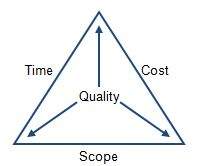Introduction
Every organization requires good leadership in order to carry out all their projects successfully. This requires the organization to appoint efficient project managers to carry out various tasks, and of course, to guide and lead the project management team and get them to a point, where they have effectively completed any given project at hand, taking into account a whole load of factors.
In order to understand how project management can run smoothly, it is important to first identify the role and the tasks carried out by the project manager. So who is a project manager and why is he/she so important?
The Role of a Project Manager
The role of a project manager basically involves handling all aspects of the project.
This includes not just the logistics but also the planning, brainstorming and seeing to the overall completion of the project while also preventing glitches and ensuring that the project management team works well together.
The Goals of a Project Manager
Following should be the the main goals for a project manager, but they are not limited to the listed ones because it very much depends on the situation:
(1) Deadlines
A project manager must always be able to carry out his role in a very effective manner.
This means that in most cases he/she would have to run against time with the clock ticking away. All projects would have deadlines, so it is the duty of a project manager to complete the project by this given date.
It should be noted that although the project manager and his team may draw up a schedule at the outset that may seem perfect, as time goes on you will find that the requirements may change, and the projects may require new strategies to be implemented and more planning to be carried out.
Time therefore could be a big obstacle for a project manager achieving his/her goal. As the project manager you should never lose sight of the deadline, your role would be to keep pushing your team to finish the work and deliver on time.
Remember that your clients' satisfaction is your number one priority.
(2) Client Satisfaction
Satisfaction of the client, however, does not mean that you rush to finish the work on time without ensuring that standards are met.
The reputation of your organization would depend on the quality of the delivery of your projects. This is another factor you should not lose sight of throughout the project.
Your role would also be to keep reminding the team members that quality is key.
(3) No Budget Overrun
No project can be started off without the preparation of the budget. Although this is just a forecast of the costs that would be incurred, it is essential that this budget is prepared after careful research and comparing prices to get the best.
You would need to consider ways of cutting costs while also ensuring that you meet the needs of the client as well as meeting the standards expected of your organization.
This budget must include all costs with regard equipment, labor and everything else. You then need to try and always stick to the budget, although it's always best to leave some allowance for a few 100 dollars for any additional expenses that may arise.
(4) Requirements Coverage
Another goal of a project manager involves meeting all requirements of the client. You would need to therefore have all specifications at hand and go through them every once in a while to ensure that you are on track.
If there is confusion as to any requirements, it would be best for you to get them cleared at the very beginning.
(5) Team Management
While you would have to ensure that all aspects of the project are maintained, you are also responsible as project manager for the happiness of your team.
You need to keep in mind that it is the incentives and encouragement provided to them that will make them work harder and want to complete the work on time, thereby helping you reach your goals.
If the team members are unhappy with the way things are being carried out, productivity will also in turn decrease, pulling you further away from achieving your goals. It is essential therefore to always maintain a warm friendly relationship with them.
The communication within the team should be very effective. They should be willing to voice out their opinions while you listen to their suggestions and consider including them in the project.
This is after all a team effort. Your goals with regard to the project are also their goals.
Conclusion
The role of a project manager is therefore no easy task. It involves taking up a lot of responsibility as each of the goals of the project must be met without making too many sacrifices.
If these goals are outlined to the project management team at the very beginning, there in no way for the delivery of the goals to be delayed in any way as everyone will always be aware of what they need to achieve and by when

